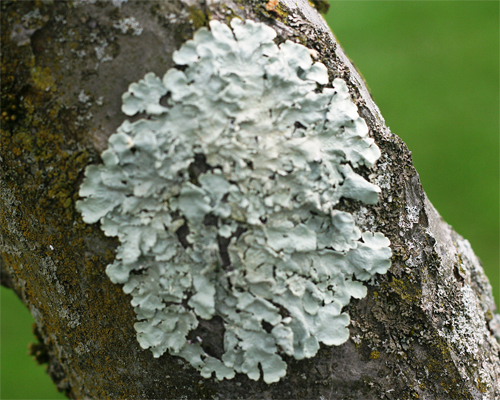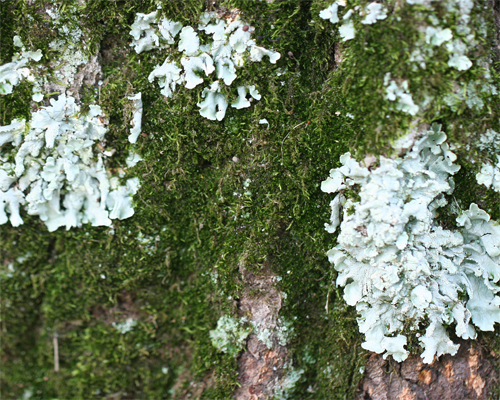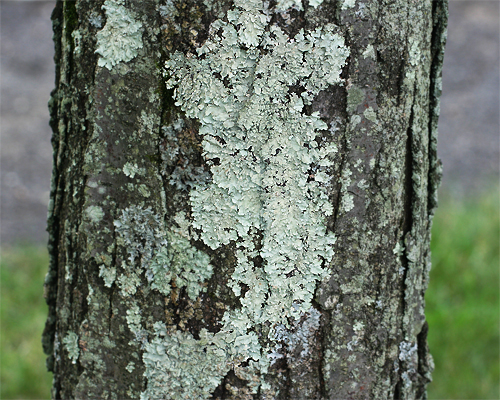
Fact Sheet FS1205
Introduction
There are at least 13,000 species of lichens living throughout the world. Lichen species are so numerous and diverse that there are individual exceptions to most general statements about them. Scientific knowledge about lichens has expanded significantly during the past few decades, and new discoveries continue. Most lichen species grow best where there is sufficient light and moisture within a moderate temperature zone. However, some lichen species are very adaptable and hardy. When left undisturbed, lichens live in many varying climates and altitudes throughout the world. Some species can survive the most unfavorable climatic extremes of arctic, alpine and desert regions by reducing metabolic activity for extended periods of time. Yet individual species may only exist within a restricted habitat or geographic range. Most lichens are very sensitive to air pollution, and like canaries in coal mines, may serve as indicators of air quality.
What Are Lichens?
Lichen is composed of two or more dissimilar organisms that form a mutually beneficial (symbiotic) relationship to produce a new vegetative body that is called a thallus. The life forms are composed of a fungus (kingdom Fungi) and most often a green alga (kingdom Protoctista) and/or a cyanobacterium (kingdom Monera). The fungal filaments make up about 80% of the lichen body. The fungus forms the outer surface to provide support and protection, absorb moisture, and collect minerals from the air. Since the fungus cannot produce its own food, it is dependent upon another life form to provide that essential function. Green algae and cyanobacteria possess the green pigment chlorophyll that is essential for photosynthesis to make food. When surrounded by the fungus, they provide the food to enable the lichen to exist and sustain itself in a suitable habitat.
Unlike plants, lichens do not have leaves, stems, or roots, or a waxy outer cuticle to control body water content. Lichens continue to grow during periods when dew, mist, and rain water are present but a summer dry period can cause them to become dormant until the next rainfall. Miniscule mineral particles that are carried by the wind during wet conditions are dissolved and absorbed by the lichen.
Lichens produce their own food using sunlight energy and do not feed on the tree bark. The lichen bodies are attached to the outer tree bark and remain on the surface. Their rhizines typically do not penetrate deep enough into the inner bark, and cause no harm to the trees they inhabit.
In contrast, certain fungi operating independently outside a lichen body will penetrate tree wounds or dead wood and feed on the host plant. The filaments of the fungal body will reside inside the tree tissue with only the fruiting bodies visible on the surface.
Lichens on Trees
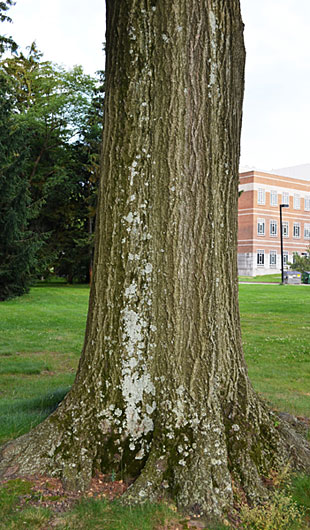
Lichen on tree trunk. (Photo by Nick Polanin.)
Lichens are often found on tree trunks, branches and twigs as the bark provides a stable place to reside to collect needed sunlight, rainwater and materials from the air. They grow on healthy trees, as well as stressed or otherwise unhealthy ones. The appearance of colorful organisms growing on the bark of trees or shrubs in the landscape sometimes causes concern for the homeowner. Homeowners may find lichens mysterious and incorrectly associate them as the cause of plant diseases or misidentify them as a type of moss.
Many lichens are more evident on stressed or old tree trunks and branches giving the appearance of a "cause and effect" association with disease and decay. The primary reason for their more likely presence on those trees and branches with reduced or partial foliation is the resulting increase in available sunlight. The bark of a healthy tree continues to expand and slough off with the growth of the tree. The bark of an older or stressed tree may become more brittle with more cracks and uneven surfaces permitting lichens to attach themselves more readily. As bark ages, it changes in chemistry, texture, and ability to retain water, thereby influencing the type of lichen capable of living there.
While fungi-within-a-lichen associations do not harm trees, some fungi outside of a lichen relationship can and do penetrate damaged or dead wood tissue and commence the decomposition of the tree. Fungi are one of the few living organisms that can break down all of the substances in wood tissue and are essential in nature in clearing away fallen tree trunks and in depositing the remaining material into the ground in the forest. A diseased or stressed tree can have both lichen and separate fungal organisms growing on the same dead branch or portion of the tree. In that case, the homeowner or tree expert may need to prune away the dead tissue for the benefit of the remaining plant. In making these types of decisions, homeowners need to understand the unique nature of lichen and the differences between those fungi within a lichen symbiotic relationship and other fungi operating separately.
Lichen Classification
Lichens do not conform precisely to the usual biological classification categories as they are composed of two or more types of organism living within a single body. Some previous classifications have been modified by recent DNA studies of lichens. The lichen’s appearance and structure are largely determined by the genetic makeup of the fungus that is generally considered the dominant organism. The lichen genus name is normally the same as the specific fungal name, while the species name is descriptive of the resulting dual organism in Latin.
Lichen Identification
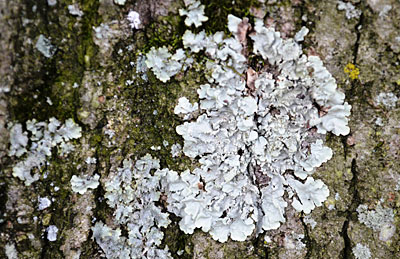
Close-up of foliose lichen. (Photo by Nick Polanin.)
Lichen identification most often is determined by the descriptive appearance, size, shape and color of the lichen body and the reproductive characteristics. Lichens are placed in groups based on their body forms and features. The three main body groupings are crustose (crust-like,), foliose (leaf-like, seen above), and fruticose (tube or beard-like strands).
The various chemicals produced by lichens are also identifying markers. Lichens also can be somewhat differentiated by the specific type of habitat where they live, such as rock, soil or trees, as well as their geographic distribution. While a 10X hand lens is essential in studying lichen specimens, microscopic examination is usually required to identify crustose lichen species.
Lichen Reproduction
Lichens may reproduce in a sexual, asexual, or vegetative manner. Lichen sexual reproduction is quite complicated as two or more organisms are contained in the lichen. The algae or cyanobacteria do not have recognizable reproductive parts and do not reproduce sexually after they are in a lichen association. The sexual fruiting bodies of lichens are those of the fungi. Most fungi that form lichens are sac fungi (Ascomycetes) that produce microscopic spores in sacs. A fungus can produce millions of spores sexually. A new lichen association can be created only when fungal spores come in contact with the appropriate algae or cyanobacteria in the correct habitat.
Lichen reproductive parts containing both algal and fungal cells may occur asexually for dispersal. In vegetative reproduction, any fragment or shred of lichen containing both the algal and fungal components that breaks off the original can form a new lichen body. In some circumstances, the fragments must break down into undifferentiated fungal and algal cells before new lichens are created.
Where Lichens Live
Different lichen species can grow on many types of surfaces, including tree bark, dead wood, bare rock, cleared soil, rusty metal, animal bones, glass, plastic and cloth. Some lichens can grow on many type surfaces while others are confined to specific types of trees or rocks. Many lichens commonly found on living tree bark are seldom discovered growing on rock or soil, as these different lichens need varying surfaces to become established.
Lichens of North America documents hundreds of species of lichens that reside on trees. It is the primary reference for lichen identification and related information in this fact sheet. Lichen species on bark do not follow the classic succession of crustose followed by foliose and then fruticose that is evident in the colonization of rock. The relatively faster growing foliose and fruticose lichens are often the first to appear on tree bark to be followed later by crustose lichen.
The growth of lichen on tree bark depends more on the physical surface of the bark than on the kind of trees. Young trees in general have a smoother bark that tends to attract crustose lichen species. As trees get older, the bark usually develops uneven broken surfaces that permit the foliose and fruticose lichens attach to the tree.
Lichens found on trees often are circular or oblong in shape with leaf-like lobes (foliose) that are parallel with or slightly higher than the bark. Each lichen body usually is limited in size to a few inches in diameter and initially may be dispersed along the bark. While they grow very slowly, i.e. one to a few mm per year, over time they tend to grow together and cover large sections of the bark.
Deciduous Trees
Lichens tend to grow on the inner trunk and branches of deciduous trees and shrubs. While the tree’s leaves may shade the available sunlight for the lichens during the warm weather growing season, the lichens do not similarly affect the leaves. After the leaves fall from the deciduous trees in the autumn, the lichens receive a greater proportion of the available sunlight and continue to grow during the colder winter months.
Conifer Trees
Conifer tree bark differs in chemistry from deciduous tree bark as it is more acidic with organic resins and gums. Conifer canopies tend to be denser and allow little sunlight to fall on the bark. In the case of conifer or evergreen trees , some lichens can survive in the resulting year-round partial shade. To obtain sunlight they also tend to locate on branches that are stressed or dead, which may again give the erroneous impression that they have contributed to the plant’s health condition.
Lichen Benefits
Lichens provide many benefits both in nature and in human culture. Lichens are eaten by many animals, such as deer, mountain goats and caribou. Many species of birds use lichen materials in constructing their nests. Certain lichens are used in producing antibiotics, while others provide the miniature plant landscape for model railroad tracks.
Lichens are numerous and important organisms in the natural environment that are generally beneficial in nature. The presence of lichens on healthy trees should be welcomed as likely positive indicators of lower levels of air pollution and a reasonably good quality of atmospheric conditions in the neighborhood. The homeowner with lichens residing on their damaged or diseased tree branches should concentrate upon identifying the real sources for the tree distress if any is seen. The lichens are not the cause for the condition of the stressed tree. However, lichens may co-exist on trees with other organisms that are causing disease or injury. Abundance lichen presence concentrated on damaged or dead wood may be a warning of present or impending invasive disease or decay caused by fungi, bacteria, viruses or insects and may require corrective action by homeowners or tree care professionals.
Selected References
Main photo (l-r): Lichens on tree trunk; Lichen and moss on oak bark; Foliose lichen on crabapple tree branch (Photos by George H. Daniel.)
March 2013
Copyright © 2024 Rutgers, The State University of New Jersey. All rights reserved.
For more information: njaes.rutgers.edu.
Cooperating Agencies: Rutgers, The State University of New Jersey, U.S. Department of Agriculture, and Boards of County Commissioners. Rutgers Cooperative Extension, a unit of the Rutgers New Jersey Agricultural Experiment Station, is an equal opportunity program provider and employer.


